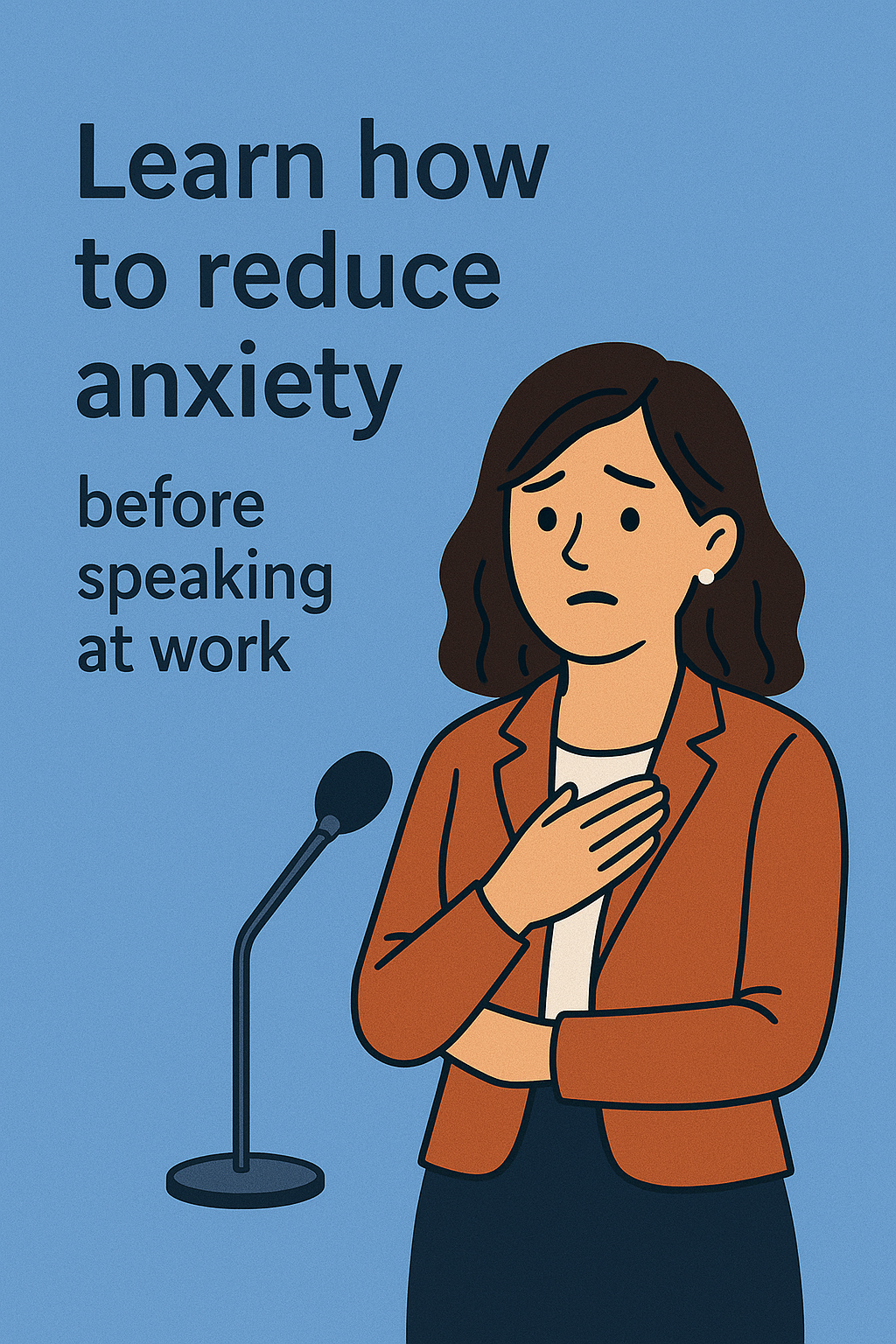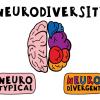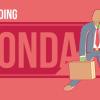
The Quiet Panic of High-Achievers - Anxiety
How to overcome presentation anxiety and work anxiety in practical ways
It's 11:58 a.m. You're about to speak. Heart pounding, mind spinning up worst-case scenarios. You smile anyway because that's the job. Then you realize you've started mid-slide, and the room feels both too bright and too loud.
If that sounds familiar, this is for you.
Anxiety at work isn't a flaw. It's your brain flagging something that matters. And high-achievers—precise, driven, conscientious—are especially good at fueling the loop:
- Situation → Ambiguous feedback
- Thought → "I'm failing"
- Body → Stomach drop
- Behavior → Over-prepare or avoid
- …which loops back again.
The good news? Loops can be interrupted from many angles: thoughts, body, or environment. Different brains need different levers. This piece maps out approaches for both neurotypical and neurodivergent brains.
What your anxiety is (really) doing
Anxiety is prediction plus protection. It blends old memories with today's signals—heart rate, attention, context—and pushes you to reduce uncertainty. That's why "just be confident" rarely works. Recognition is step one; interrupting the loop can happen at any strand.
"how to stop freezing in meetings"
"presentation anxiety at work"
"confidence under pressure"
"imposter syndrome at work"
"first-time manager confidence"
"how to calm nerves before presentation"
"voice shaking in meetings"
"reduce anxiety before speaking at work".
You're also not anxious in a vacuum. Hybrid work, constant pings, shrinking networks—all raise load. Chronic loneliness carries health costs equal to smoking 15 cigarettes a day. That matters at work because connection is performance infrastructure.
And if sleep is tangled up in your anxiety, know this: insomnia isn't a moral failure. Research shows both sleep and anxiety spiral in bidirectional loops. Compassionate experiments help more than shame.
Two Routes — Pick What Fits Your Brain
Your brain's wiring determines which tools work best. Start with your Route, then add skills as needed.
Route NT — Neurotypical
Cognitive tools for thought-driven anxiety
Use when: You catch yourself catastrophizing, mind-reading, or replaying mistakes. Your anxiety lives primarily in your head.
- 90-second Spotlight Audit. Ask: "If a peer did what I just did, how would I judge them?" This punctures spotlight effect bias.
- Label the bias. "I'm noticing all-or-nothing thinking." ACT research shows naming creates distance.
- Rumination breaker. Say "Stop," stand up, move for 60 seconds. Breaks the thought-body loop.
- Gratitude rep. Three hyper-specifics from the last day. Over time, this shifts attention currency.
Values link: Spotting biases isn't about being "less sensitive." It's about protecting what you care about: clear, respectful work under pressure.
When stress spikes: Under high stress, everyone's executive function goes offline. NT brains can borrow ND Route tools when cognitive approaches aren't working — because chronic stress does to NT brains what ADHD does to ND brains: tanks working memory, kills task-switching ability, makes impulse control nearly impossible. That's why the ND toolkit works for everyone in crisis.
Route ND — Neurodivergent
Energy, sensory, and executive function tools
Use when: The issue is capacity, not character—masking, context-switching, fluorescent lights, RSD (rejection sensitivity), or executive function offline. ADHD, autism, dyslexia, sensory processing differences.
- Energy mapping. Track what drains/charges you. Build a 10% buffer pre-drain.
- Sensory kit. Loops, fidgets, fabric, lighting—performance infrastructure, not crutches.
- Task initiation scaffold. First action stupid-small: "open doc," not "finish deck."
- Meeting alternatives. Written input windows or async updates often yield better signal-to-noise.
- Explicit instructions. Every tool includes its own instructions. Every time. Because working memory isn't reliable when bandwidth is low.
Values link: These aren't hacks to "fit in." They're how you show up thorough and thoughtful—without burning the engine.
Beyond Brain Wiring: Environment & Skills
Some challenges aren't about how your brain is wired—they're about broken systems or skills you haven't built yet. Both Routes benefit from these tools.
Environmental Navigation
Sometimes it really is the system
Use when: Anxiety spikes track predictable friction—ambiguous priorities, calendar Tetris, toxic dynamics, isolation. This isn't about your wiring; it's about navigating broken environments.
- Two-sentence renegotiation. "Given X and Y, I can deliver A by Friday, or B+C by next week. Which serves best?"
- Decision windows. Protect one 45-minute focus block daily.
- Deliberate connection. Pick one relationship this month to strengthen.
Values link: Designing the container lets you deliver and still have a life you recognize.
Tools for toxic workplaces, office politics, and systemic problems live in Communication, Stress Management, and Emotional Mastery Pillars.
Skill-Building Reps
Confidence from doing
Use when: You're facing genuinely new demands—bigger room, harder audience. Your Route determines which tools work best, but building reps works for everyone.
- Micro-exposures. 2-min recording → 5-min teammate → 8-min manager. Gradual reps build earned confidence.
- Constraint practice. One slide, one story, one ask. Limits surface clarity.
- Post-rep debrief. Keep → tune → one small next step. Treat as iteration, not verdict.
Values link: You want to be the person who makes a clear ask, even in a loud room. Reps make that real.
If you lead people
Anxiety isn't a "toughness" gap; it's a design and capacity problem. Invest in health and you get better work and better lives. The global case is strong: improving workforce health can create up to $11.7 trillion - McKinsey, in economic value through reduced attrition/absenteeism/presenteeism and improved productivity. Practically? Meeting‑free focus blocks, humane on‑call rules, predictable priorities, manager training on psychological safety, and access to skills—not slogans—pay off.
Practical levers:
- Meeting-free focus blocks
- Humane on-call rules
- Predictable priorities
- Manager training on psychological safety
- Access to actual skills (not slogans)
Relationships are infrastructure. Teams with positive connection are safer, more resilient, and more effective. Normalize async work when cognition benefits, clarity-seeking, and declining optional video. That's not coddling—it's operational maturity.
When anxiety collides with sleep
Two truths:
- Basics help—morning light, dimmer screens, jotting worries.
- Chronic insomnia is a condition, not a personal flaw.
What helps: compassionate experiments—get out of bed if wide awake, protect bed for sleep, seek care if it's chronic. If you're balancing caregiving, shift work, or health limits, your "best" will look different.
A quick self-check for this week
- Which Route fits your brain—NT (thought-driven) or ND (capacity/sensory)?
- What's one 10% nudge you can try from your Route's toolkit?
- Which relationship gets one deliberate touchpoint (five minutes counts)?
Behind the tools: beliefs, values, emotions, and reasoning interact in real time. Tech can amplify both—scrolls that fuel comparison, or pings that reinforce support. That's why matching tools to your actual brain wiring works better than one "right way."
When it gets messy (because it will)
You'll over-prepare the wrong slide. You'll blank on a question you could answer in your sleep. You'll come home drained with zero charm left. That doesn't mean you're failing. It means you're human. Tiny adjustments—kept consistent—change the experience and outcomes.
Keep going, your way
Presentation anxiety?
Start with confidence under pressure
Focus/energy?
Explore focus & self-management
Systemic friction?
Find your route forward
Emergent Skills offers two distinct routes—NT (cognitive/thought-based tools) and ND (neurodivergent-affirming capacity and sensory strategies)—plus skills for navigating broken environments and building confidence through practice.














